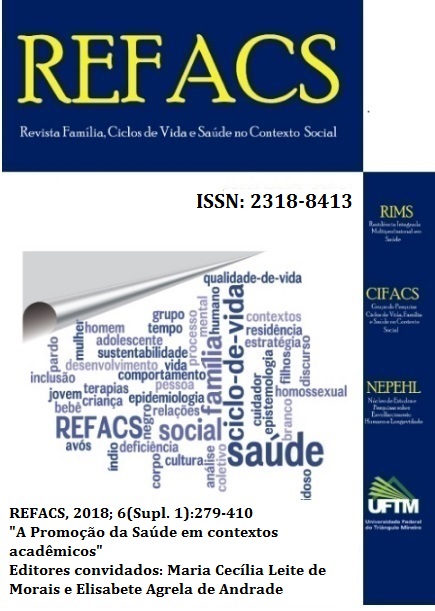O discurso das mães de bebês em tratamento para icterícia neonatal
DOI:
https://doi.org/10.18554/refacs.v6i0.2381Palavras-chave:
Icterícia, Relações mãe-filho, CulturaResumo
Esta investigação tem como objetivo verificar o conhecimento popular e o conhecimento científico das mães de bebês com icterícia em tratamento com fototerapia. Tratou-se de uma pesquisa de campo, com observação direta e abordagem qualitativa, baseada no Discurso do Sujeito Coletivo (DSC), realizada em meados de 2011. A pesquisa foi realizada em uma maternidade estadual na cidade de Mafra em Santa Catarina, com mães de bebês em fototerapia para o tratamento da icterícia. Evidenciaram-se 7 ideias centrais e 11 DSCs. Os resultados revelaram que as mães entrevistadas não reconheceram a icterícia neonatal como um agravo, assim como a fototerapia como medida de tratamento. Evidenciou-se que as mães trazem consigo crenças e conhecimentos populares sobre a icterícia, os quais precisam ser respeitados e valorizados para o fortalecimento do vínculo e do cuidado.
Referências
Fujiwara R, Haag M, Schaeffeler E, Nies AT, Zanger UM, Schwab M. Systemic regulation of bilirubin homeostasis: potential benefits of hyperbilirubinemia. Hepatology. 23 oct 2017 [citado em 24 out 2017]. Disponível em: https://www.ncbi.nlm.nih.gov/pubmed/29059457. Doi: 10.1002/hep.29599
De Luca D, Romagnoli C, Tiberi E, Zuppa AA, Zecca E. Skin bilirubin nomogram for the first 96 h of life in a european normal healthy newborn population, obtained with multiwavelength transcutaneous bilirubinometry. Acta Paediatr. 2008; 97(2):146-50.
Slusher TM, Day LT, Ogundele T, Woolfield N, Owa JA. Filtered sunlight, solar powered phototherapy and other strategies for managing neonatal jaundice in low-resource settings. Early Hum Dev. 2017; 114:11-5.
Yueh MF, Chen S, Nguyen N, Tukey RH. Developmental, genetic, dietary, and xenobiotic influences on neonatal hyperbilirubinemia. Mol Pharmacol. 2017; 91(5):545-53.
Campos CSA, Moreira MVL, Cardoso L. Enfermagem e o cuidado humanístico: proposta de intervenção para a mãe do neonato sob fototerapia. Ciênc Enferm. 2006; 12(1):73-81.
Kern S, Reuter S. Neonatal hyperbilirubinemia - an update for South Dakota physicians. South Dak J Med. 2015; 68(1):23-7.
Campos ACS, Cardoso MVLL. Tecnologia educativa para a prática do cuidado de enfermagem com mães de neonatos sob fototerapia. Texto & Contexto Enferm. 2008; 17(1):36-44.
Liu CC, Chen YC, Yeh YP, Hsieh YS. Effects of maternal confidence and competence on maternal parenting stress in newborn care. J Adv Nurs. 2011; 68(4):908-18.
Lefèvre F, Lefèvre AMC, Teixeira JJV. O discurso do sujeito coletivo: uma nova abordagem metodológica em pesquisa qualitativa. Caxias do Sul: EDUCS; 2000. 138p.
Silva IAS, Souza KV, Souza IEO. PROENF: Programa de Atualização em Enfermagem: saúde materna e neonatal: ciclo 1, módulo 2; Porto Alegre: Artmed; 2010. 132p.
Lefevre F, Lefevre AMC. Discurso do sujeito coletivo: representações sociais e intervenções comunicativas. Texto & Contexto Enferm. 2014; 23(2):502-7.
Alcântara AM, Vesce GEP. As representações sociais no discurso do sujeito coletivo no âmbito da pesquisa qualitativa. In: VIII Congresso Nacional de Educação; 11-15 nov 2008; Curitiba, PR. Curitiba: EDUCERE; 2008. v. 1, p.724-1599.
Kenner C. Enfermagem neonatal. Rio de Janeiro: Reichemann & Affonso; 2001. 375p.
Teti DM, Hess CR, O'Connell M. Parental perceptions of infant vulnerability in a preterm sample: prediction from maternal adaptation to parenthood during the neonatal period. J Dev Behav Pediatr. 2005; 26(4):283-92.
Kuzniewicz MW, Wickremasinghe AC, Wu YW, Mcculloch CE, Walsh EM, Wi S, et al. Incidence, etiology, and outcomes of hazardous hyperbilirubinemia in newborns. Pediatrics. 2014; 134(3):504-9.
Almeida MFB, Nader PJH, Draque CM. Icterícia neonatal. In: Lopez FA, Campos JRD, editores. Tratado de pediatria. São Paulo: Manole; 2010. p. 1515–1526.
Wennberg RP, Watchko JF, Shapiro SM. Maternal empowerment - an underutilized strategy to prevent kernicterus? Curr Pediatr Rev. 2017; 13(3):210-9.
Luchesi B, Beretta M, Dupas G. Conhecimento e uso de tratamentos para icterícia neonatal. Cogitare Enferm. 2010; 15(3):506-12.
Xu B, Tang F, Li X, Chen S, Hong J, Chen H. Study on reducing neonatal jaundice level at home by intervention of traditional chinese medicine sunbathing. Chin Arch Tradit Chin Med. 2013; 10(2):53-80.
Downloads
Publicado
Edição
Seção
Licença
Este trabalho está licenciado sob uma licença Creative Commons Attribution-NonCommercial 4.0 International License.



